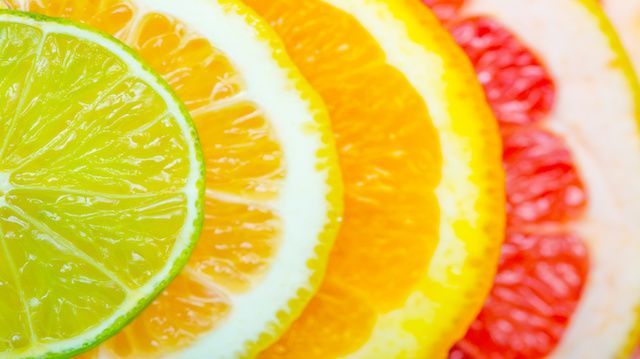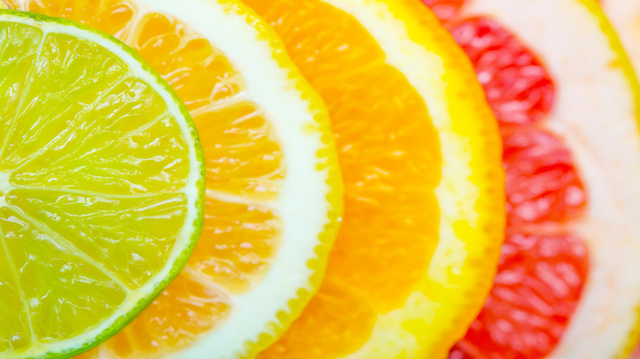
It may not cure the common cold, but vitamin C still does a whole lot of good for your body. In fact, what you don’t know about vitamin C could change your life. Vitamin C is water soluble, meaning your body doesn’t store it, so you’ll need to eat fresh fruits and vegetables to get your daily fix. Our list of the top 15 vitamin C foods will help you make better dietary choices.
Why do we need vitamin C?
There are so many reasons why we need vitamin C in our diet. According to research, vitamin C is essential in collagen synthesis. Collagen is the protein used to build skin, tendons, ligaments, blood vessels and cartilage. This makes vitamin C especially important for those dealing with osteoarthritis. Vitamin C also helps your body absorb non-heme iron (plant sources), making it essential for vegetarians and vegans.
Vitamin C is also an antioxidant; it helps block damage caused by free radicals, substances that wreak havoc on your DNA. Over time free radicals contribute to aging, cancer, heart disease and arthritis.
You may not be in danger of getting scurvy anytime soon, but too little vitamin C in your diet can leave you deficient. The National Institutes of Health (NIH) proposes that signs of vitamin C deficiency include dry split hair, gingivitis, bleeding gums, and dry scaly skin, to name but a few. Even worse, vitamin C deficiency can lead to high blood pressure, gallbladder disease, certain types of cancer and plaque buildup in blood vessels, leading to heart attack or stroke.
How much C do we need?
A study by the NIH suggests that our bodies easily absorb approximately 400–500 mg per day; any more than that and we simply flush it down the drain — so to speak. When dosing higher than 1000 mg per day, the absorption rate falls to less than 50 percent.
The Institute of Medicine (IOM), a division of the National Academies of Sciences, Engineering and Medicine, advises that adult males need 90 mg a day. Adult women need 75 mg a day. Smoking depletes 35 milligrams of vitamin C per day; so smokers need to increase their intake. Health conditions may increase your vitamin C needs as well.
Here is our list of the top 15 foods that give you the most vitamin C bang for your buck.
Guava
Guava, an incredibly high source of vitamin C, contains 206 mg per fruit — that’s at least three times more vitamin C than an orange! Choose ripe fruit. Juice or add one to your breakfast smoothie. Make sure to remove the hard seeds before juicing or blending.
Sweet peppers
Who would have thought — sweet and crunchy red peppers have more vitamin C than oranges. A half-cup serving delivers a whopping 95 mg of vitamin C. Add raw peppers to fresh, nutrient-rich gazpacho soup.
Papaya
Papaya is deliciously sweet and butter-soft. Half a papaya contains 94 mg of vitamin C. Once considered exotic, today you can find papaya year-round. Look for fruit with skin turning from green to yellow and soft enough to press your thumb into the flesh.
Oranges
Don’t skip your morning OJ — just opt for freshly squeezed instead. Three-quarters of a cup supplies 93 mg of vitamin C, and one medium orange supplies 70 mg.
Grapefruit juice
Grapefruit juice is another great source of vitamin C. Slightly less than orange juice, it still delivers 70 mg in three-quarters of a cup. Half a grapefruit provides 39 mg of vitamin C.
Kiwifruit
Chock-full of vitamin C, this low-glycemic, high-fiber fruit actually contains more vitamin C than an equivalent amount of orange. Bright green and speckled with edible seeds, add kiwifruit to your next fruit salad. One medium kiwifruit gives you 64 mg of vitamin C.
Green peppers
With a tangy taste and crunchy texture, green peppers make an excellent addition to salads. Half a cup of raw green pepper delivers 60 mg of vitamin C.
Broccoli
Eat your broccoli! Your mother always said so, and now you have good reason. Half a cup of cooked broccoli provides 51 mg of vitamin C. Instead of boiling it, roast it with garlic or shred it raw and make a slaw.
Strawberries
This little powerhouse is packed full of antioxidants. Half a cup of freshly sliced strawberries contains 49 mg of vitamin C. Studies suggest that eating strawberries lowers your risk for developing chronic diseases, including cancer and cardiovascular disease.
Brussels sprouts
Brussels sprouts are another great way to get your daily dose of vitamin C. Half a cup delivers 48 mg. These powerful members of the cabbage family are delicious steamed, boiled or roasted with garlic, olive oil and parmesan cheese or lemon juice.
Snow peas
 The versatile snow pea, often used in Asian stir-fries, is another great source of vitamin C. Half a cup of cooked snow peas contains 41 mg. Whether you boil, steam, stir-fry or blanch snow peas, keep it to three minutes to retain their vibrant color and vitamins.
The versatile snow pea, often used in Asian stir-fries, is another great source of vitamin C. Half a cup of cooked snow peas contains 41 mg. Whether you boil, steam, stir-fry or blanch snow peas, keep it to three minutes to retain their vibrant color and vitamins.
Tomatoes
The humble tomato is well known for its rich concentration of lycopene, a powerful antioxidant that may protect cells from damage. Tomatoes are also a great source of vitamin C. One-quarter of a cup of juice contains 33 mg of vitamin C, and one raw tomato contains 17 mg.
Cantaloupe
Cantaloupe, a rich source of beta-carotene, protects against prostate cancer and lowers the risk of colon cancer. It actually has about 300 times more beta-carotene than a fresh orange. If that’s not reason enough to include cantaloupe in your diet, it’s also a good source of vitamin C. Half a cup provides 29 mg.
Cooked kale
If you haven’t tried the “queen of greens” yet, here’s one good reason to. Half a cup of cooked kale delivers 28 mg of vitamin C. Sauté it with garlic, olive oil or coconut oil, or add it to your soups and stews.
Cabbage
Cabbage is a delicious and versatile source of vitamin C. Half a cup of cooked cabbage provides a 28 mg dose. Roll and stuff, or sauté it to enhance the flavor.
Cauliflower
Not to be outshone by broccoli, cauliflower has its own impressive list of health benefits. Apart from being a rich source of vitamins and nutrients, it also helps your body detoxify. Half a cup of raw cauliflower contains 26 mg of vitamin C.
Rapini
Rapini, also known as broccoli rabe, is one of the most popular greens in Italy. Although slightly bitter in taste, some find it addictive. Rapini is another great source of vitamin C — half a cup of cooked rapini delivers 24 mg of vitamin C. Peel the tough, lower outer stalks and boil before sautéing to remove some of the bitterness.
Fruits and vegetables really are the best sources of vitamin C. To maintain a healthy balance, choose whole, fresh, organic produce.
—The Alternative Daily
Sources:
https://umm.edu/health/medical/altmed/supplement/vitamin-c-ascorbic-acid
https://ods.od.nih.gov/factsheets/VitaminC-HealthProfessional
http://iom.nationalacademies.org/Activities/Nutrition/SummaryDRIs/~/media/Files/Activity%20Files/Nutrition/DRIs/New%20Material/5DRI%20Values%20SummaryTables%2014.pdf
http://www.ncbi.nlm.nih.gov/pubmed/15077879
http://www.dietitians.ca/Your-Health/Nutrition-A-Z/Vitamins/Food-Sources-of-Vitamin-C.aspx
https://www.ksre.k-state.edu/humannutrition/nutrition-topics/functionalfoods-documents/Beta_Carotene_How_Safe_and_Effective.pdf
http://www.ncbi.nlm.nih.gov/pubmed/16704986

